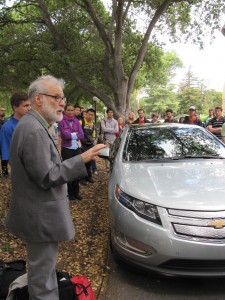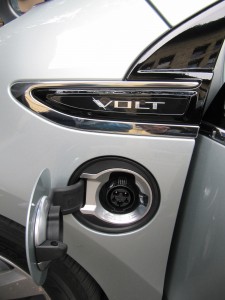
Not everyone spends sunny afternoons debating the technical differences between popular electric car models, but one Stanford engineering student with a thick German accent tackled the topic excitedly. With his messy auburn hair flowing in odd directions, he could have passed for a mad scientist styled after Back to the Future. The extraordinary thing about his discussion of atkins cycle engines and smart grids, though, was that more than 100 other students listened intently to each of his words at the university last month. All of them had carved time out of their schedules to check out a Chevy Volt that General Motors engineers brought to campus.
A Chevy Volt has a giant electrical socket where most cars have a latch to open the gas tank. This didn’t shock any of the students who made time to see it at Stanford. They were there to explore the technology that makes this car the most efficient hybrid available in the United States.
Cutting-edge research, student interest, and new seminars are cropping up across campus to address transportation as a sustainability challenge. Students from fields as diverse as urban planning and electrical engineering are increasingly engaged with strategies to help move a growing population from point A to point B without pushing fossil fuel consumption through the roof.
The Chevy Volt event attracted about a hundred members of the Stanford community over the course of a few hours according to Lee Schipper, an organizer of the event. Schipper teaches a graduate level course called Sustainable Mobility and serves as a Senior Research Engineer at Stanford’s Precourt Energy Efficiency Center. The majority of his students were present, as were those of Gil Masters, who teaches a course on electric power.
All attendees listened closely as Byron Shaw, the General Motors engineer who brought the car to Stanford, described its technical features and patterns of electricity use.
“It’s a pretty exciting time,” Shaw said. The ability to charge plug-in hybrid and fully electric cars in public places is “coming, but it’s not quite there yet.” The ability to charge these cars in public places could make them convenient enough for drivers to propel electric vehicles into the mainstream.

Transportation is a key part of the global energy challenge. Planes, trains, ships, automobiles, and pipelines account for 27 percent of all energy use in the world according to the Energy Information Administration. Ninety five percent of this transportation-specific energy comes from petroleum, making the sector especially important to key goals of limiting politically sensitive oil imports and curbing greenhouse gas emissions. Many experts consider more sustainable transport key to slowing climate change, and the number of forward thinking Stanford students responding to this issue seems to be reaching a critical mass. Transportation research on campus is becoming popular in response to a global problem.
Within a single lecture in Lee Schipper’s class, he touched on the larger issues of oil imports and environmental sustainability to put the lecture in perspective, as well as honing in on the physical challenges of charging electric vehicles in densely populated cities. Students asked detailed questions about both engine technologies and marketing strategies. In this class, students mostly come from engineering backgrounds, but there are a “blessed few from humanities,” according to Schipper.
Despite growing interest in transportation issues, not all students who end up working in the transportation sector specifically planned to do so. Colin Vanlang, a graduate student in civil engineering, found himself working on the design of a subway tunnel in New York for a summer internship even though he had taken no transportation courses at Stanford. For Colin, transportation infrastructure provided a useful application for his structural engineering skills even though he wasn’t specifically interested in its environmental impact.
Another student with a deep academic interest in energy, Alex Luisi, has chosen not to focus specifically on transportation. He sees greener electricity sources as a more compelling area to study because electric vehicles can only be as sustainable as the electricity sources they use.
Even within the general realm of sustainability, some specific topics resonate with individual students more than others. However, the 5-year-old Precourt Energy Efficiency Center and the 2-year-old Precourt Energy Institute have helped drive transportation education on campus into the spotlight.
“That’s why I was hired,” said Schipper. The large crowd at the Chevy Volt presentation suggests that his passion for sustainable transport is beginning to spread.

Pingback: New York Electric Car July 12, 2011 | New York Electric Vehicle Owner